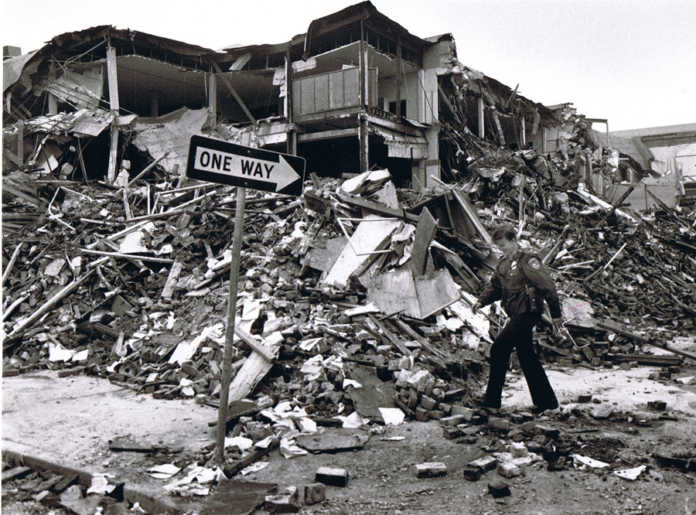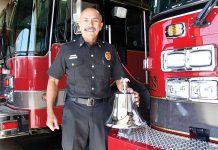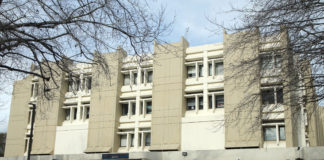
WATSONVILLE—When the Loma Prieta earthquake struck at 5:04 p.m. on Oct. 17, 1989, Second Harvest Food Bank CEO Willy Elliott-McCrea was in Watsonville, talking about disaster preparation.
It was a strange bit of irony, and it took the presence of then-Watsonville Fire Chief Gary Smith to prompt McCrea to respond properly.
“The shaker just kept going and going, and finally Gary said, ‘Willy, get under the table,’” McCrea said.
If his immediate reaction was a bit slow, it was McCrea’s response as a service provider – and that of his counterparts countywide – that helped the community weather the disaster in the days, months and years to come.
What followed immediately was weeks of all-hands-on-deck scrambling to find temporary shelter for thousands of displaced residents, and to organize a constant stream of trucks bringing donated supplies, McCrea said.
It was also a struggle at times to handle the legions of volunteers that arrived in the area after heeding the call for help.
McCrea said he was faced with distributing two million pounds of food over 18 months to fill an unprecedented amount of need.
“All of a sudden overnight we had 25,000 people living outdoors, many in the parks, many in their backyards,” McCrea said. “We went from serving 15,000 people a month to serving 100,000 people a month, 25,000 a week. So it was always a scramble.”
Second Harvest provided food for people in several impromptu community campgrounds, and at times in the front yards of people unwilling to leave their homes, but scared to go back inside for fear of aftershocks.
The food bank also tried for a few days to serve as a feeding kitchen, an endeavor that quickly proved to be untenable.
“It only took a day or two for us to realize this was not going to work with all these delivery trucks,” McCrea said.
So organizers called St. Patrick’s Church and told leaders they were going to put refrigerators and shelves on a truck and bring them there.
That, McCrea said, was the creation of a new food providing organization that has become a Santa Cruz County mainstay.
“Overnight St. Pats opened up Loaves and Fishes,” he said. “It was founded three days after the earthquake.”

St. Patrick’s Chruch sustained major damage during the earthquake. — The Pajaronian file
A law enforcement perspective
The earthquake toppled the steeple of St. Patrick’s Church and severely damaged most of the downtown buildings. Many of these were damaged beyond repair and marked for demolition.
This included the iconic Ford’s Department Store and the I.O.O.F. building, which sent a cascade of debris that killed a woman.
In the meantime, law enforcement officials were tasked with keeping the area secure, in addition to their other public safety duties.
Former Watsonville Police Chief Manny Solano did not know it was the earthquake that had caused a rockslide he saw near Pasatiempo as he drove over Highway 17 on his way home.
Solano called the incident in to emergency dispatchers, who told him they were already inundated with similar calls from all around the county. He soon learned just how bad things had gotten.
“I headed down into Santa Cruz and started seeing all the columns of smoke, and the radio was just going off like crazy,” he said.
Solano said he wanted to go back and check on his family and his newborn son, an endeavor made more difficult because the roads and bridges were destroyed.
“It was a big issue,” he said. “We couldn’t get around, so I couldn’t get to my house just over the bridge in Pajaro.”
Solano met up with a fellow officer, who drove him home on his motorcycle. He checked on his family, got his own motorcycle and got to work.
“Then we were on continuous shifts for hours on end, especially for the first couple days,” he said. “For the first 24 hours we just worked. We were just working off adrenaline, and nobody else was getting relieved.”
Later, the 24-hour shifts changed to two 12-hour shifts.
Solano was assigned to the night shift, which largely involved guarding downtown from looters and enforcing a dusk-to-dawn curfew.
At the time, WPD Capt. Chuck Carter said in an interview that looting was not a big problem.
Still, Solano remembers isolated incidents, such as finding two men pushing a shopping cart laden with computers they had taken from E.A. Hall Middle School.
Because phone lines were gone and power was out – and computers were still in their infancy – officers reverted to handwritten reports and other archaic methods of policing, Solano said.
Their job was made even more difficult by the emergency dispatch system, which was operating in a van in the police station parking lot after losing power.
An additional challenge came from the large numbers of displaced people living in campgrounds in Ramsay and Callahan parks, and at the town plaza.
While the U.S. National Guard eventually arrived to provide security, WPD was still the primary law enforcement agency tasked with keeping the camps secure.
Carter said that normal overtime costs for the department were about $100,000 per year. That number quickly compounded.
“In the two weeks following the earthquake we spent, just on overtime, $120,000,” he said.
All of this is woven into a course Solano teaches at the San Jose police academy known as South Bay Regional Public Safety Training Consortium. The class, called “significant events and unusual occurrences,” draws on his experiences during the earthquake.
A key lesson, he said, is being prepared to work without the benefit of phones and computers.
“We used the old Marine motto of ‘improvise, adapt and overcome,’” he said.
Solano described driving through his hometown as “surreal.”
“It was sad to see old buildings I grew up in; the bakery downtown, the church I was baptized in, just all these memories,” he said. “My memory of it was real sadness, watching people suffer severe loss and knowing that they didn’t have money to do the repairs or they were going to be waiting a long time to have it done.”
Role of the airport
The centerpiece of all of this was Watsonville Municipal Airport, which became the unsung hero of the Loma Prieta response after damaged roads and bridges isolated the county.
“For three or four days it was the only way in and out of the county,” former airport manager Don French said, adding that pilots brought in more than 1 million tons of supplies.
This cemented the importance of the airport in the eyes of county leaders, some of whom had been considering closing it.
Airport officials soon coordinated an airlift during which pilots with private planes delivered food, water and supplies in addition to dignitaries, said Sarah Chauvet of the Watsonville Pilots Association.
“There were pilots from airports all up and down the coast, bringing in all that was needed,” she said.

Watsonville Municipal Airport became a crucial link for outside supplies when the county roads were cut off. — The Pajaronian file
All hands on deck
Lisa Angell was a staff nurse in Watsonville Community Hospital’s emergency room and a coordinator for the paramedic base station when the earthquake hit.
At the time, the hospital was located at 292 Green Valley Road.
She said the ferocity of the earthquake surprised even native Californians used to subterranean shaking and earthquake drills.
“Most of us in the hospital were thrown to the ground,” she said. “It was very uncharted territory in terms if experiential reference.”
The ER was in shambles, Angell said, and all the medical staff, some of whom had been injured protecting their patients from falling objects, had no choice but to soldier on.
After a cacophony that filled every molecule of the air, Angell said she was astounded by a silence in which “you could hear a pin drop.”
“The ER doc looked over at me and said, ‘we’re going to get busy,’” she said.
After that, Angell said, “we got to work.”
Within a half-hour, there were several hundred people in the hospital parking lot, she said.
“The community converged on us within a very rapid period of time,” she said. “One guy came in on a door in the back of a pickup truck.”
During those first hours, officials inspected the building for damage as administrators set up a command center in the parking lot and workers moved intensive care patients and newborn babies.
To make matters worse, the hospital lost its oxygen and medial gas systems, and officials were worried about radioactive materials being spilled, Angell said.
Organized chaos
Patsy Gasca had been a longtime volunteer with different organizations when she heard a request for translators broadcast on the radio by the Santa Cruz County chapter of the American Red Cross.
They asked her to come in immediately. Gasca has been with the organization since, and is now the Disaster Programs Manager. She celebrates her 30th anniversary along with the quake.
As a new volunteer, Gasca said she was put to work as a caseworker helping people affected by the disaster.
She also helped with processing and training volunteers to support emergency shelter, feeding and counseling services.
Many people, she said, didn’t know if their homes were still standing.
“It was what I call organized chaos,” she said.
Part of that chaos came from the buckled roads and otherwise damaged infrastructure. Gasca said it took two hours to traverse the two miles from her residence to the Red Cross headquarters.
Another snag, she said, came from the weather.
“We got hit by rain, we got wind,” she said. “Every type of weather that we could get, we got.”
In addition, hundreds residents refused to go back inside their homes after thousands of aftershocks continued to rattle the area. Instead, they pitched their tents atop wooden pallets in impromptu campgrounds throughout the city to get off the cold, damp ground.
Soon, the Federal Emergency Management Agency brought emergency trailers, placing them in the fairgrounds, and a campground at Crestview Drive and Freedom Boulevard.
“I was amazed at what I saw coming in as a volunteer,” Gasca said. “A small city gets erected within a matter of hours.”
Classes go on
Where students couldn’t go to school, Pajaro Valley Unified School District (PVUSD) officials brought classes to them.
The temblor shook several portable classrooms off their foundations at Ohlone Elementary School, and caused the roof to collapse on others, said Raul Gonzales, who has been a custodian at the school for nearly four decades.
At the time, the school was housed on the campus of Pajaro Middle School.
Red Cross trucks arrived to distribute water and food to families in the following days, while Gonzales and other workers began repairs.
After about a month, students returned to classes, and Ohlone moved to its current location on Bay Farms Road.
In the meantime, PVUSD bussed students to an impromptu school on the Santa Cruz County Fairgrounds.
“I thought it was going to take months and months to get things back in place, but to my astonishment they were back by December,” he said. “We were able to let the students know we were there for them, and make them feel safe. It was really an eye-opening experience.”

One of many fundraisers is held in downtown Watsonville for St. Patrick’s Church in 1990. — The Pajaronian file
Strength of humanity
When the quake hit, former Watsonville Fire Chief Gary Smith said he heard a rumbling that sounded like a freight train.
“We got out and we could see brown brick dust rising and we had seven fires going at the same time,” he said.
Smith then took command of the emergency services system.
Because power was out and an emergency generator was not working, emergency dispatchers moved to a trailer in the parking lot. A centerpiece of that, he said, was a dispatcher with two radios, one for fire and the other for police.
Meanwhile, other emergency services occurred on an impromptu basis.
In one instance, a receptionist still on duty at the fire station heard about a fire on Brennan Street, and dispatched a nearby water tender truck that had been destined to fill a swimming pool. That was good news for firefighters battling the blaze, who had been fretting about diminished water sources.
“God was on our side that night,” Smith said.
While firemen were busy with serious emergencies, Smith said, workers from a popup clinic were treating less serious injuries and other problems.
That, he said, was the birth of Salud Para la Gente, which provides meals, food and medical services for hundreds of low-income people every day.
“In a matter of months they became what they are today,” Smith said.
Smith described the incident as six to eight hours of scary catastrophic efforts, followed by five years of recovery.
He said the response to the earthquake took a countywide effort and an understanding of not only the available resources, but the knowledge of how – and when – to deploy them.
“I had never managed anything that big,” he said. “Nobody on our team had. It was a learn-as-you-go that actually turned into a fairly decent response.”
Perhaps one of the most remarkable things about that time, Smith said, was that the community soldiered on, despite the adverse conditions. There was relative peace throughout the city, he said, with little crime.
“It was a hellish experience, and it was a time when the strength of humanity came out,” he said.












That was a challenging time. I had some very dedicated employees come to work at Longs Drug Store the next day.
Such a well written article. Truly eye opening for those of us who were born after the earthquake! Thank you!
We are remember those that were lost today. 35 years and they are stilled missed